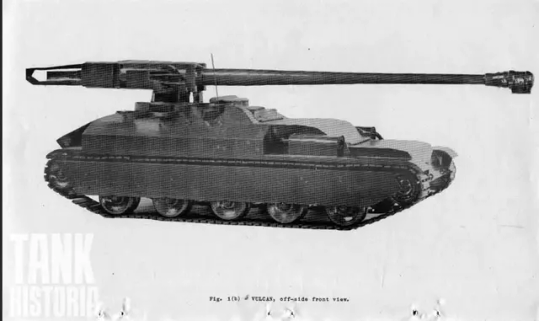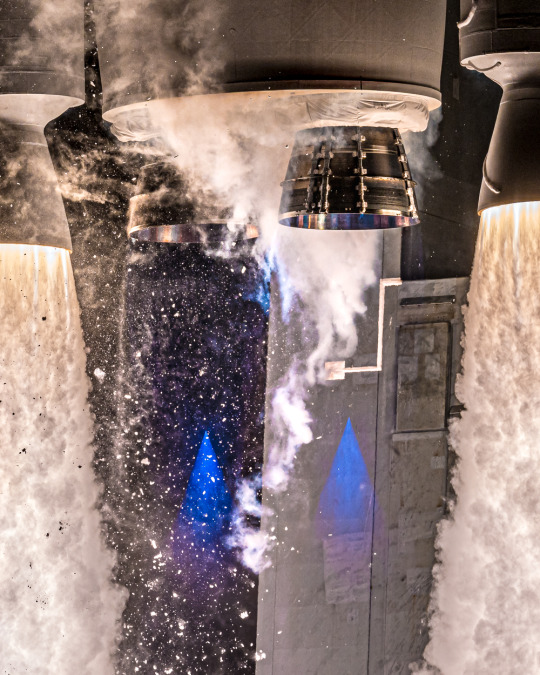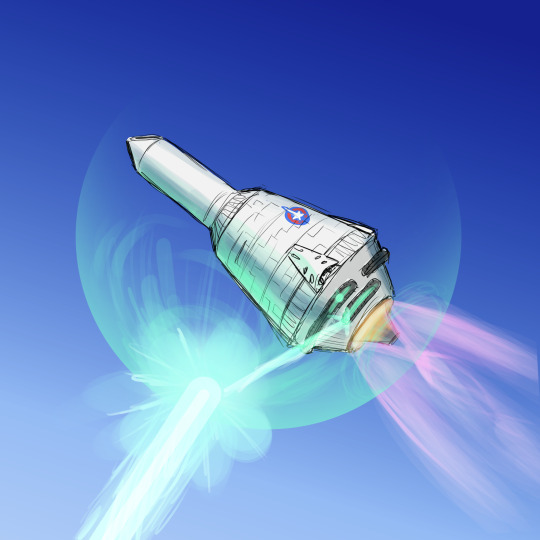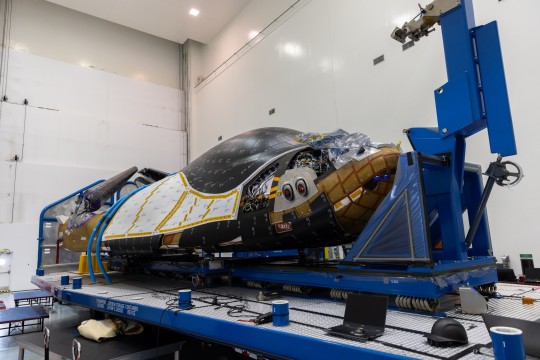#vulcan-rocket
Explore tagged Tumblr posts
Link
Astronomy Daily - The Podcast: S03E172 Welcome to Astronomy Daily, your source for the latest space and Astronomy news. I'm Anna, your host, and today we have an exciting lineup of stories that will take us from groundbreaking rocket launches to mind-bending discoveries in the depths of space. Let's dive into the latest developments in space exploration and astronomical research. Highlights: - United Launch Alliance's Vulcan Rocket Flight: ULA's second Vulcan rocket flight launched last Friday, marking a pivotal test for certifying the new launcher for high-priority national security missions. Despite an anomaly with one of the solid propellant boosters, the mission showcased the rocket's resilience and the successful performance of its core stage and Centaur upper stage. - Peculiar Galaxy Captured by Hubble: The Hubble Space Telescope has captured an image of NGC 4694, a peculiar galaxy in the Virgo cluster. This cosmic oddball, a lenticular galaxy, combines features of both elliptical and spiral galaxies and has undergone a collision with a nearby dwarf galaxy, offering insights into galactic evolution. - Blue Origin's Upcoming Spacecraft Debut: Blue Origin is set to debut a new spacecraft on their NS-27 mission, scheduled for October 7. This uncrewed flight will feature technology upgrades and carry twelve research payloads, marking a significant step in Blue Origin's commercial spaceflight ambitions. - Record-Breaking Triple Star System: NASA's TESS has discovered a tightly packed triple star system, TIC 290-06-1484, challenging our understanding of stellar systems. This discovery highlights the power of collaborative efforts between professional astronomers and citizen scientists. - James Webb Space Telescope's Surprising Findings: The James Webb Space Telescope has revealed unexpectedly bright and mature galaxies in the early universe, prompting a reevaluation of galaxy formation models. These ancient galaxies, observed just 300 million years after the Big Bang, challenge existing cosmological theories. - NASA's Parker Solar Probe Update: NASA's Parker Solar Probe has completed its 21st close approach to the sun, matching its distance record and reaching unprecedented speeds. Upcoming encounters promise even closer passes, providing invaluable data about the sun's atmosphere and magnetic fields. For more space news, visit our website at astronomydaily.io. There, you can sign up for our free Daily newsletter, catch up on all the latest space and Astronomy news with our constantly updating newsfeed, and listen to all our previous episodes. Don't forget to follow us on social media. Just search for #AstroDailyPod on Facebook, X, YouTubeMusic, and TikTok. Thank you for tuning in. This is Anna signing off. Until next time, keep looking up and stay curious about the wonders of our universe. Sponsor Link: NordVPN the reliable VPN service you need to look after your online security...get the deal!
#astronomy#blue-origin#early-galaxies#galaxy#hubble#james#nasa#ngc-4694#parker#peculiar#solar#space#space-exploration#star#system#telescope#triple#united-launch-alliance#vulcan-rocket#webb
2 notes
·
View notes
Text

Vulcan at sunrise l John Kraus
#vulcan#rocket launch#space#astrophotography#sky#astronomy#solar system#stars#planets#galaxy#universe#ULA#united launch alliance
680 notes
·
View notes
Text

Happy Star Trek Day 🖖
#star trek#star trek day#spock#the search for spock#the final frontier#the voyage home#the wrath of khan#the undiscovered country#the motion picture#star trek the original series#vulcan#generations#Rocket boots
52 notes
·
View notes
Text

POV your game is about to crash
#Helminth Pull + Melee Vortex + Jat Kittag with Vulcan Blitz is not perhaps mm the most 'efficient' build#but consider: it is REALLY funny#standing in one place feeding techrot into a rocket-powered woodchipper
2 notes
·
View notes
Text
So. She's been made into a print...

This requires no explaination
#I've got some other Star Trek stuff on there too I think they're fun#That dumb drawing of Shatner doing Rocket Man was also on there for a bit but I sold all of them at various cons sdhf#though as of writing this post that print is also my first and only etsy sale LOL#star trek#star trek lower decks#t'lyn#vulcan as a motherfucker
970 notes
·
View notes
Text
Vulcan Rocket?
These 3 videos tell us of the successful launch even with loss of a booster’s nozzle. I listed them as they should be watched if you haven’t heard of what Tory Bruno called an anomaly. One question, “Whose head did the nozzle land on?” I would guess the nozzle burnt up before hitting the ground. The nozzle most likely crashed with in the cleared zone for the Vulcan Rocket launch. I asked…

View On WordPress
0 notes
Text
ULA Rolls Second Vulcan Rocket To Its Launch Mount
United Launch Alliance’s CERT-2 rocket on its way to the launch mount at Space Launch Complex 41 at Cape Canaveral on September 30, 2024.Photo: United Launch Alliance United Launch Alliance has moved its second Vulcan Rocket from their Vertical Integration Facility at Space Launch Complex 41 to the launch mount. Final preparations can now begin for a launch scheduled for NET (not earlier than)…
0 notes
Text

SLUF's Up! Crew loading an A-7 Corsair's M61A1 Vulcan 20 mm cannon. The small, little SLUF could carry 1,030 rounds of ammo and over 6,800 kg of bombs, rockets, and missiles, making it a formidable strike/attack aircraft.
@RealAirPower1 via X
#a 7 corsair#ling temco vought#fighter bomber#aircraft#navy#aviation#us navy#carrier aviation#vietnam war aircraft#cold war aircraft
37 notes
·
View notes
Text

The "Vulcan" tank prototype. Designed by STT in 1952, the Vulcan was one of the first tanks designed to have an unmanned turret. It was armed with a 123mm gun with a unique rocket powered loading mechanism and protected by up to 16 inches of armor.
51 notes
·
View notes
Link
Astronomy Daily - The Podcast: S03E170 Welcome to Astronomy Daily, your source for the latest space and Astronomy news. I'm Anna, your host, and today we have a packed episode covering exciting developments from NASA's Voyager mission to solar flares and lunar rovers. Let's dive into some fascinating stories from across the cosmos. Highlights: - Voyager 2's Ongoing Journey: NASA has made the tough decision to power down the plasma science instrument aboard Voyager 2, now over 12.8 billion miles from Earth, due to diminishing power supply. Despite this, Voyager 2 continues its groundbreaking exploration with four other active instruments, extending its mission well into the 2030s. - Solar Flares and Geomagnetic Storms: The sun unleashed two powerful flares, including an X 7.1 class flare, the second strongest of the current solar cycle. This eruption caused disruptions to radio communications and is expected to trigger a geomagnetic storm, offering a spectacle for Aurora watchers. - Annular Solar Eclipse: Sky watchers in select locations witnessed a stunning annular solar eclipse, transforming the sun into a "ring of fire." This rare celestial event was visible across parts of the Pacific Ocean, including Hawaii, southern Chile, and Argentina. - NASA's Lunar All Terrain Vehicle: As part of the Artemis missions, NASA is developing the Lunar Terrain Vehicle (LTV), an unpressurized rover for future lunar exploration. A prototype, the Ground Test Unit (GTU), is being tested at Johnson Space Center to refine the design and ensure safe lunar operations. - Vulcan Centaur Rocket's Second Flight: United Launch Alliance's Vulcan Centaur rocket is set for its second test flight, a crucial step towards certifying it for the US Space Force. This mission, carrying a mass simulator, aims to assess the rocket's performance for future national security missions. - ESA's New Norcia Antenna: The European Space Agency has installed a massive 122-ton reflector dish for its newest deep space communication antenna in New Norcia, Australia. This will enhance ESA's ability to communicate with distant spacecraft and support international missions. For more space news, visit our website at astronomydaily.io. There, you can sign up for our free Daily newsletter, catch up on all the latest space and Astronomy news with our constantly updating newsfeed, and listen to all our previous episodes. Don't forget to follow us on social media. Just search for #AstroDailyPod on Facebook, X, YouTubeMusic, and TikTok. Thank you for tuning in. This is Anna signing off. Until next time, keep looking up and stay curious about the wonders of our universe. Sponsor Link: One great deal today from NordVPN...the secure VPN service you need in your life for not very much money. Check out our great deal: www.bitesz.com/nordvpn
#annular-solar-eclipse#artemis#astronomy-news#centaur#deep#instrument#interstellar-space#lunar#lunar-rovers#missions#nasa-voyager2-mission#plasma#rocket#science#solar-cycle-25#solar-flares#space#terrain#vehicle#vulcan
3 notes
·
View notes
Text


Liftoff of ULA Vulcan l John Kraus
l First U.S. commercial robotic launch to the Moon l ULA(United Launch Alliance) l more info at NASA
#rocket launch#vulcan#ULA#astrophotography#nasa#artemis mission#moon#science#stars#solar system#astronomy#galaxy#planet#cosmos#universe#sky
642 notes
·
View notes
Text
Who up vulcanizing the whoopee stick in the ham wallet? Or cattle prodding the oyster ditch with the lap rocket?
11 notes
·
View notes
Text

So first let's pray to Vulcan, ugly god of forge and flame/
And also wise Minerva, now we glorify your name/
May you aid our ship's designers now and find it in your hearts/
To please help the lowest bidders who constructed all the parts!
"Rocket Rider's Prayer" by Stephen Savitzky
31 notes
·
View notes
Text
It's bigger than anything I wanna write, but here's a fun trek fic for you
Years ago Pike found an alien while he was out hiking, all smashed up and hurt from his ship crash
He and his doctor friend M'Benga patched him up all nice
Now the alien (Spock, obvs) is ready to fix his ship but he needs help
Pike gets his friends who knows about about this involved
Scotty is an engineer, he's onboard with anything
Kirk is a creative sort, he'll be able to help bridge the gap between alien and human
The three of them get to working. Steadily the secret of Spock and his alien ship gets out
Uhura is visiting and picks up one of Spock's notebooks. She knows the language isn't human and takes it home. By the time she explains herself everyone's pleased to have someone else around who understands the ship language
Kirk "accidentally" lets it slip to McCoy. Really he wanted his mate along. McCoy doesn't believe a bit of it until they actually launch and then he's furious. He desperately reads the notes M'Benga left him and asks Spock some very invasive questions cos suddenly he's responsible for an alien's health
Scotty runs into something none of them can fix and gets permission to involve Chekhov who can make rocket fuel out of fucking anything
Sulu literally wanders across them and watches for like two weeks before introducing himself
They all head off to try and return Spock. The plan is to slingshot around the sun, deploy a life pod with Spock in it heading vaguely for Vulcan and hope he makes it
It goes wrong. Spock dumps his Katra in McCoy's head and dies to save everyone else
They decide to get to Vulcan anyway and return Spock's body. There's discord about it but Kirk puts his foot down
Classic McCoy losing his marbles, then losing his shit when they get there and find out what Spock did
Save Spock, la di dah
They all join the Vulcan space agency as a contract group and get a ship and go enjoy being in space together as mercs
17 notes
·
View notes
Note
OOC question (unless any OCs wanna take it in which case validd) - does Mellanus have any interesting ways of getting stuff to orbit or is it just conventional (for Star Trek) spacecraft?
Hi, this is Lieutenant J.G. Eaurp Guz. Most warp-capable societies use a combination of fusion rockets (usually impulse drives) and antigravity manifolds for lifting payloads into orbit. Yes, you heard me right. You'd think it'd be transporters, right? And yes, transporters get used a lot, but their energy efficiency is abysmal compared to any kind of ballistic approach. So when it comes to moving large amounts of material, the go to is always gonna be some manner of shuttlecraft. Antigravs are used to get off the ground, then they're slowly disengaged and the impulse drive is used to accelerate against the antigrav (Whenever you're using an antigrav you're basically storing downward acceleration you're going to have to take care of inertially eventually), and then accelerate to orbit. Shuttlecraft impulse engines are usually tuned to use purely subspace-field-coil-accelerated atmospheric gases for propulsion in-atmosphere, which avoids harmful radiation or excessive thrust power that can damage structures and humanoid hearing and soforth. That's why the Cerritos usually lands infrastructure equipment using shuttles. Now, the thing is, Mellanus is only kind of a warp capable planet. Aside from the USS Liberty, which had a lot of help, no crewed mellanoid spacecraft has left the Zwo-nmu planetary system. Any kind of subspace technologies is, for the moment, still highly specialized. And we also don't know how to make our own fusion reactors. (at least, not ones that break even.) So, in short, we still use conventional rockets for the most part.

The current heavy-lift rocket, though, is this beautiful thing. See, during the Dominion war, the Federation installed fusion-powered phaser and shield grid stations on Mellanus, to protect against potential invasion from the Dominion, who might have seen another fluidic species as either an asset or a threat. In peacetime, the fusion powerplants were redistributed to tie into the power grids, at least where possible. But a crazy beautiful engineer by the name of Urbleagh came up with the idea to reuse old laser-launch plans thought up before first contact and marry them with the phaser-repeater warships that were designed but never launched during the war. By aligning the frequency of the ground-based phaser and its shields in just the right way, the phaser-propelled launch vehicle can collect thermal energy from the phaser beam and use it to power an aerospike rocket engine with water propellant. That nets a specific impulse of over 900 seconds and a high thrust to weight ratio. And because there's no reactor onboard, it can be used in reusable or expendable configuration without losing much. This phaser rocket is the new heavy lifter for the space program, and has been in operation since 2377. I still haven't gotten to see one launch myself. The rocket is not used for gooed (ed note: crewed) launches because of the risk of total vaporization with no capability for abort if there's a malfunction in the phaser or the shields. The space program's other workhorse is the older and more reliable NTR-IV, a closed cycle gas core nuclear thermal rocket SSTO. Fission or chemical fueled SSTOs aren't really plausible on heavier worlds like Earth or Vulcan or Tellar Prime, but they work well enough on Mellanus because the delta-v to orbit is lower and so's the gravity. Side note: There's a reason Pre-Surak Vulcans, Orions, and Tellarites invented nuclear pulse rockets before fusion or fission-thermal drives. If your planet is so heavy that getting to orbit is difficult full stop, then you'll tend to just go ahead and invent the crazy deathbomb superrocket, and when you GET to orbit, you'll be better equipped to explore the rest of your system. Earth is juuuust small enough that chemical rockets and NTRs sufficed for orbiting, and electric, NTR, and fusion rockets were later used for space exploration. Of course the post-Surak Vulcans didn't do crewed space exploration again until they'd harnessed antigravity and impulse drives, but that's a highly ideological thing I think. Anyway, the NTR-IV is a mandatory reuse vehicle due to the nuclear reactor, so the turnaround time is pretty long. For relatively small launches, the Mellanus Space Program still uses conventional chemical rockets, primarily methalox or hydrolox rockets. Solid rocket boosters are rare these days. Rutherford jokes that that's because Mellanoids will always prefer a fluidic version of a technology over a solid one, which is honestly not far off. In space (for instability reasons that haven't yet been hammered out this can't be done in atmosphere), mellanoid rockets use fission-impulse drives, which are NTRs (usually solid core or liquid core, but I think open cycle gas core has been tried) with an additional solid core reactor powering subspace field coils, as in a normal fusion-impulse drive. This raises the effective exhaust velocity substantially, and basically sucks free energy out of subspace. (that's a massive, massive oversimplification, but my next shift is soon and I don't have time to get into the details.) Does that answer your question? I might have gotten lost at some point.
13 notes
·
View notes
Text




"Teams process Dream Chaser Tenacity, Sierra Space's uncrewed cargo spaceplane, inside the Space Systems Processing Facility (SSPF) at NASA's Kennedy Space Center in Florida on Monday, May 20, 2024, following its arrival from the agency's Neil Armstrong Test Facility in Ohio. Dream Chaser Tenacity will undergo final testing and prelaunch processing inside the high bay of the SSPF ahead of its inaugural launch atop a ULA (United Launch Alliance) Vulcan rocket from nearby Cape Canaveral Space Force Station. The reusable transportation system is contracted to perform a minimum of seven cargo missions to the International Space Station as part of the agency's efforts to expand commercial resupply services to low Earth orbit."
Photo credit: NASA/Kim Shiflett
Date: May 20, 2024
NASA ID: KSC-20240520-PH-KLS01_0022, KSC-20240520-PH-KLS01_0009, KSC-20240520-PH-KLS01_0004, link
#Tenacity#DC-101#Sierra Space Dreamchaser#Dreamchaser#Sierra Space#Lifting Body#Spaceplane#Neil Armstrong Operations and Checkout Building#OCB#Kennedy Space Center#KSC#Florida#May#2024#my post
53 notes
·
View notes